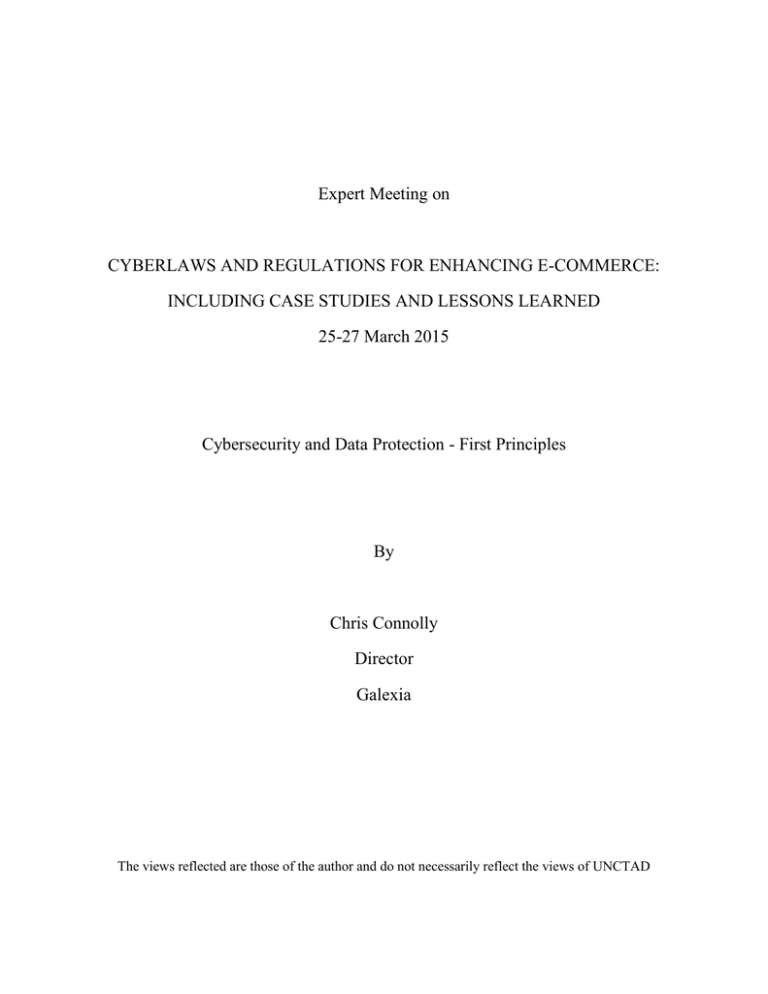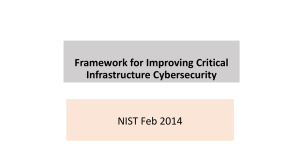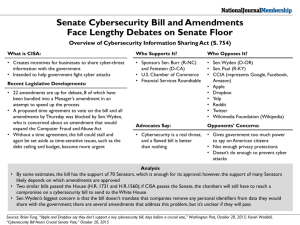Expert Meeting on CYBERLAWS AND REGULATIONS FOR ENHANCING E-COMMERCE:
advertisement

Expert Meeting on CYBERLAWS AND REGULATIONS FOR ENHANCING E-COMMERCE: INCLUDING CASE STUDIES AND LESSONS LEARNED 25-27 March 2015 Cybersecurity and Data Protection - First Principles By Chris Connolly Director Galexia The views reflected are those of the author and do not necessarily reflect the views of UNCTAD Cybersecurity and Data Protection – First Principles EXPERT MEETING ON CYBERLAWS AND REGULATIONS FOR ENHANCING E-COMMERCE (UNCTAD) March 2015, Geneva Chris Connolly Overview The tension between cybersecurity and data protection The increased role of cloud computing services (and related challenges) The role of Government » The ‘Do No Harm’ principle » Improving cybersecurity infrastructure » Mutual legal assistance » Ensuring global rights The role of the private sector » Global companies – global responsibilities » The failure of Intermediaries Major Tensions between cybersecurity and data protection Persistent issues Mass collection and retention of data (usually communications meta-data) Identity and authentication of individuals v anonymity Governance, oversight, transparency and legal redress Newer issues Cross-border surveillance Forum shopping and outsourcing illegal surveillance practices Attacks on privacy enhancing technology and infrastructure The increased role of cloud computing services Positive impact Negative impact The most innovative development in computing for years Benefits not spread evenly, especially in developing countries Significant cost savings, allowing reallocation of resources Potential for dominance by multinational vendors Multiple fail-safes and backups that reduce the risk of data loss Lack of standards / consistency in security certifications and audits (although now improving) Privacy protection ‘layers’ rather than a single point of privacy protection Massive data sets now a ‘honey pot’ for attacks Data held offshore subject to law enforcement / security access Potential for exploitation of data and concerns about the absence of data custodians New opportunities for ‘big data’ analysis and collaboration For more analysis see the UNCTAD Information Economy Report 2013, The Cloud Economy and Developing Countries, http://unctad.org/en/PublicationsLibrary/ier2013_en.pdf The role of Government (1) The ‘Do No Harm’ principle » First Principle for Governments should be to avoid harm to individual rights and security infrastructure when pursuing cybersecurity objectives. » Examples of harm include the deliberate undermining of encryption standards, requiring ‘back door’ access to IT infrastructure etc. Improving cybersecurity infrastructure » National cybersecurity strategies and Public Private Partnerships (PPPs) » See the BSA / Galexia EU CyberSecurity Maturity Dashboard 2015 at: » http://cybersecurity.bsa.org/index.html The role of Government (2) Mutual legal assistance » Complex labyrinth of multinational and bi-lateral agreements » Each agreement contains a different data protection test » The strongest test is that surveillance requests should be ‘necessary, proportionate and narrowly tailored’ (EUUS terrorist finance tracking program – TFTP 2010) » Many agreements only state ‘necessary and proportionate’ » However, some agreements have no test Ensuring global rights » Important for countries to extend human rights protections to all residents / consumers, not just “citizens”, to ensure global coverage and protection The role of the private sector Global companies – global responsibilities » Key participants in cybersecurity (through innovation, PPPs, reporting to CERTs, community education etc.) » Important to keep egos in check and collaborate for the common good » The Do No Harm principle should also apply to the private sector The failure of Intermediaries » Banking / payments sector failing to restrict cybercrime » Trustmark and security certification schemes failing to protect consumers – – FTC prosecution of TRUSTe 2015 ($200,000 fine for misleading and deceptive conduct) “Sites certified as secure often more vulnerable to hacking, scientists find”: http://securitee.org/files/seals_ccs2014.pdf Outstanding Issues? There are still significant gaps in basic cybersecurity infrastructure Complex and overlapping international agreements on cybersecurity legal assistance often lack strong data protection tests Disappointing that intermediaries have not played their part in managing cybersecurity and data protection (a single intermediary might manage thousands of companies) Important to recover trust in law enforcement, national security and the private sector through developing global protections and followng the Do No Harm principle





